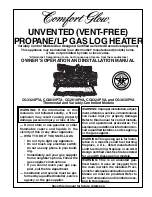
Mighty Therm VW - PW Volume Water Heaters
Page 7
2D-1. Outdoor Air Supply
When combustion air comes directly through an
outside wall, each opening must have a minimum free
area of at least one square inch for each 4,000 BTU/h
input of the total input rating of all appliances in the
enclosed area. (In Canada, refer to CGAB149.1 and .2.)
2D-2. Indoor Air Supply
Confined and non-confined areas have different
requirements for installation. Consult the latest edition
of the National Gas Code for installation requirements.
2D-3. Exhaust Fans or Vents
Any equipment which uses air or removes air
from the heater room can use up the combustion air
supply or reverse the natural draft action of the venting
system. This could cause flue products to build up in
the heater room. More air must be supplied to make up
for the decrease.
2E. Venting of Combustion Products
2E-1. General Information
When installed indoors, the drafthood must be
connected to a venting system. The venting system
must be installed by a qualified installer and in
accordance with the latest edition of ANSI Z223.1. In
Canada, the installation must be in accordance with
CAN1-B149.1 or .2, and any local codes that apply.
The vent pipe must have a listed vent cap, and
extend at least 2 feet (0.6 m) above any object within a
10 foot (3.0 m) radius.
NOTE: Do not use sheet metal screws at the
snap lock joints of Type B double-wall gas vents.
Do not weld or bolt the vent pipe to the heater
drafthood. The weight of the stack must not rest on the
heater. The drafthood and heater top must be easily
removable for normal heater service and inspection.
WARNING
Avoid ending heater vents near air conditioning or
air supply fans. The fans can pick up exhaust flue
products from the heater and return them inside the
building, creating a possible health hazard.
Avoid horizontal runs of the vent pipe and 90
degree elbows, reductions, and restrictions. Horizontal
runs should have at least a 1/4 inch (6.3 mm) rise per
foot in the direction of flow. Support a vent connector
for the design and weight of the material used to
maintain clearances and physical damage and separate
of joints.
Always use double-wall or insulated vent pipe
(Type B or equivalent).
Required Net Free Opening Area
Directly from Outside
At Top
At Bottom
Model
in.
2
cm
2
in.
2
cm
2
175
44
284
44
284
250
63
406
63
406
325
82
529
82
529
400
100
645
100
645
Note: For screens or louvers, add 50%.
Table 2. Air Openings to Outside.
Figure 14. Indoor installation and venting.
Notes:
1.
The drafthood must sit directly on top of the heater
as shown and must not be altered in any manner.
2.
An Underwriters' Laboratories listed vent cap is re-
quired to eliminate downdraft and allow the heater
to function properly.
3.
Use approved roof fitting.
Vent terminated at
least 24 in.
(610mm) above
any object within
10 ft. (3.0m)
10 ft.
(3.0m)
2 ft. (0.6m)
Listed Vent
Cap
Storm Collar
Roof Jack
Adequate
Air Supply
To Room
Top and
Bottom
12 in.
(305mm)
All Sides
Drafthood
1/14 in. (6mm)
Minimum Pitch
Per Foot of
Horizontal Pipe
flue gases from inside the building (see Figure 14 and
Table 2 ). Laars does not recommend indoor
installations that do not provide combustion air from
outside the building.
Heater rooms which are confined spaces require
two permanent air supply openings: one within 12
inches (305 mm) of the ceiling, the other within 12
inches (305 mm) of the floor.
NOTE: Check with louver manufacturers for
net free area of louvers. If screens or louvers are
installed, add 50 percent for each screen/louver to the
net free area Check all local codes applicable to
combustion air.








































